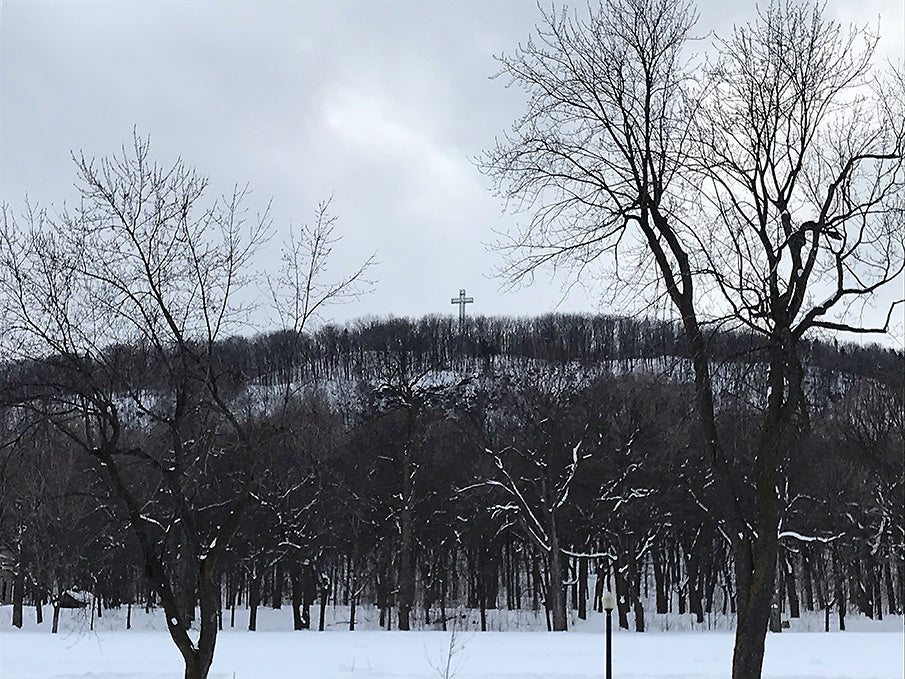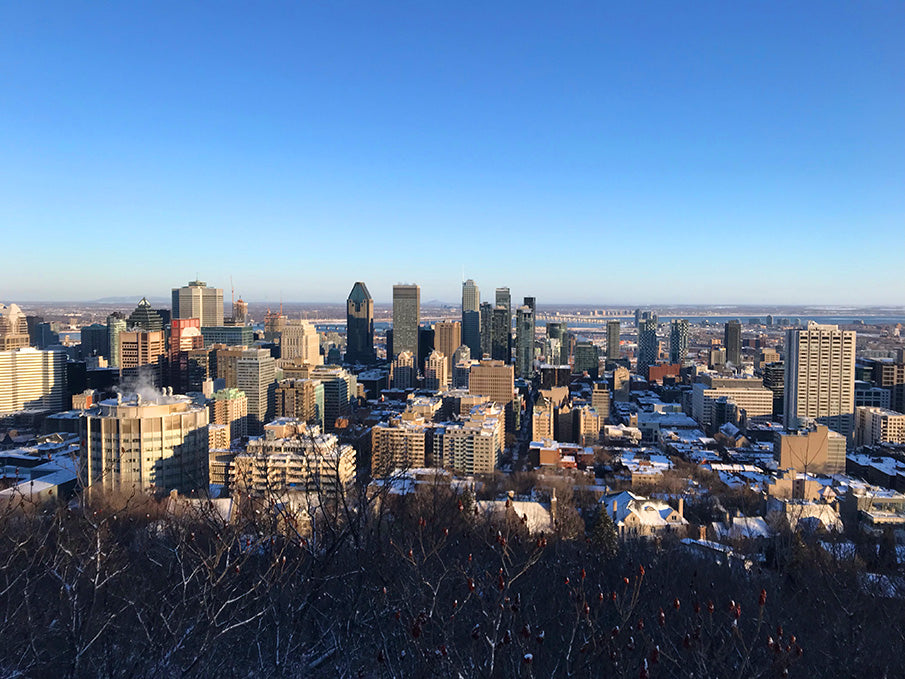
Text: Raymonde Paradis | Copyediting: Marie Léger-St-Jean
We wanted to showcase on this T-shirt the main attractions of our city, Montreal. Let us briefly describe the elements that make up our logo.

The Biosphere at Parc Jean Drapeau, Montreal, Quebec, Canada.
1. The Biosphere
The Biosphere is located in Parc Jean-Drapeau on Saint Helen’s Island. Its current name refers to the environmental museum, but it was the United States Pavilion in the 1967 World’s Fair, or Expo 67. A true masterpiece designed by architect Richard Buckminster Fuller, the sphere was the most visited pavilion during the Expo.
The Biosphere is still the largest building of its kind in the world. Unfortunately, a fire destroyed the cladding in 1976, leaving only the internal structure. It remained vacant for a long time before the City of Montreal put it back to use in 1990. Along with Environment Canada, it developed a museum tasked with raising awareness regarding major environmental issues, be they air- or water-related, climate change, or sustainable development, among others.

The Angel Monument at the Mont Royal in winter.
2. The Sir George-Étienne Cartier Monument
The Angel Monument, which has stood across from Parc Jeanne-Mance for a century, watches over tam-tam players and dancers on Sundays in the summertime. The monument erected in 1919 is actually dedicated to Sir George-Étienne Cartier (1814-1873), a politician who played a major part in the birth of the Canadian Confederation. However, the allegorical figure of the angel which overlooks the statue of the renowned elected official has taken over the collective imagination. It represents Pheme or Fama, the personification of fame and renown.
It was in 1911 that the idea emerged of dedicating a monument to George-Étienne Cartier to commemorate the centenary of his birth. Donations were collected throughout the British Empire, and newspapers around the world reported on the project, entrusted to one of Canada’s top sculptors at the time, George William Hill. The 1919 inauguration ceremony of the monument showcased new technological advances. Indeed, through the miracle of electricity, His Majesty George V unveiled the sculpture live from his castle in Balmoral, Scotland. At the touch of a button connected to the monument by telegraph cables, the king lowered the Union Jack that concealed the statue in front of a stunned crowd.

The Angel Monument at the Mont Royal in spring.

The Mount Royal with his cross, in winter.
3. Mount Royal
Mount Royal, which Montrealers colloquially call “the mountain,” has borne that name ever since Jacques Cartier’s second voyage to Canada. After landing in Hochelaga, a village that would become Montreal, Cartier climbed the nearby hill, which he named “Mount Royal” in honour of King Francis I of France. It became property of the Sulpicians, seigneurs (lords) of the entire island. They exploited its agricultural potential by renting it to settlers. The farmers were gradually replaced by wealthy bourgeois families, attracted by the beauty of the surroundings.
In the middle of the 19th century, the City of Montreal decided to restore access to its less well-off citizens and allow them to also enjoy the wonderful natural landscape in the middle of the cityscape. The development of the park, opened in May 1876, was entrusted to Frederick Law Olmsted, then the most renowned landscape architect on the American continent. Mount Royal Park has become one of Montreal’s most important green spaces ever since. As for the cross that overlooks the mountain, the structure that still stands today dates back to 1924.

The Montreal Metro
4. The Montreal Metro
The Montreal Metro opened in 1966 and is currently made up of four lines designated by different colours. The idea that Quebec’s largest city should have a subway had been floating around since the beginning of the 20th century. However, it was not until the early 1960s that serious studies and planning were undertaken. The 1961 plan provided for three lines dug underneath the city centre to reach its most populated areas.
Construction for the first two lines began in May 1962, under the leadership of Mayor Jean Drapeau and Lucien L’Allier, the director of the Ministry of Public Works, who was later dubbed the “father of the metro.” The plan for the third line was abandoned in favour of the yellow line, which would lead to the South Shore via Saint Helen’s Island, where the metro station would provide access to the famous Expo 1967. It should be noted that the island itself was enlarged using the rocks excavated while the metro was being built and that the adjacent Notre Dame Island was created entirely from the same material.
Since then, plans to extend the metro are constantly being brought back to the agenda. The latest is the pink line promised by Valérie Plante, mayor of Montreal since 2017.
5. Place Ville Marie
Place Ville Marie (PVM for short) is a downtown real estate complex with four office buildings located above a shopping mall. However, “Place Ville Marie” is most often used to refer to the central building, which was the starting point to redefining the downtown area in the mid-20th century. With its unusual structure, its rotating beacon that casts its light over the entire city and its observation deck that offers a 360-degree panorama of Montreal, PVM remains one of the city’s flagship building and an undeniable tourist attraction.
In the 1950s, there was a huge pit downtown where the railway tracks were. A whole slew of projects meant to cover up this trench were put forth. Developer William Zeckendorf won the contest with his plan for a complex. He enlisted architects Ieoh Ming Pei and Henry N. Cobb to design the cruciform tower that would become Place Ville Marie, inaugurated on September 13, 1962.
Additions to the tower over the years have brought it to 42 storeys, making it the fourth tallest skyscraper in Montreal.

The 1000 de la Gauchetière, downtown Montreal
6. The 1000 De La Gauchetière
The city’s tallest skyscraper, the 1000 De La Gauchetière, was built for its 350th anniversary, celebrated in 1992. With its 51 floors, it reaches the maximum legally permitted height: that is, the elevation of Mount Royal. Its postmodern architecture was inspired by nearby buildings. Its grey granite with coppery accents blends in with its neighbour, the Mary, Queen of the World Cathedral.
Since the main function of the building is to accommodate businesses, it houses mainly office spaces, but it’s best known for its indoor skating rink. Located on the ground floor and covered by a huge glass dome, the Atrium Le 1000 ice rink is just as popular as when it opened. It brings joy to both young and old, be it summertime or wintertime.

Downtown Montreal, view from the Belvedere



0 comments